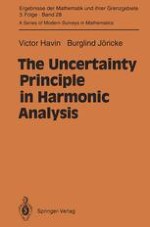1994 | OriginalPaper | Buchkapitel
Functions and Charges with Semibounded Spectra
verfasst von : Victor Havin, Burglind Jöricke
Erschienen in: The Uncertainty Principle in Harmonic Analysis
Verlag: Springer Berlin Heidelberg
Enthalten in: Professional Book Archive
Aktivieren Sie unsere intelligente Suche, um passende Fachinhalte oder Patente zu finden.
Wählen Sie Textabschnitte aus um mit Künstlicher Intelligenz passenden Patente zu finden. powered by
Markieren Sie Textabschnitte, um KI-gestützt weitere passende Inhalte zu finden. powered by
Let us imagine a device transforming an input f into the output L(f); both are some functions of time (“signals”). The domain χ of the operator L (i.e., the set of all admissible inputs) and the range of L are vector spaces consisting of (generalized) functions defined on ℝ. We assume L to be linear. Set τ h (f)(t) := f(t - h). The signal τ h (f) is a shift of f; if h > 0, then τ h (f) is h time units later than f. Suppose that our device is indifferent to the choice of the origin of the time axis. In other words, τ h (χ) ⊂ χ, L(τ h (f)) = τ h L(f) (h ∈ ℝ, f ∈ χ). Such operators L are called shift invariant. It is well known that (under some natural restrictions) a shift invariant operator L can be represented as a convolution: (1)$$L\left( f \right) = a*f\quad \left( {f \in X} \right)$$ where a is a (generalized) function. It coincides with the output corresponding to the δ-input: a = L(δ). Real devices obey the causality principle (“no output without an input”). This means that if f ∈ χ, t0 ∈ ℝ and f | (-∞, t0) =0, then L(f) | (-∞, t0) = 0. At any given moment to such a device takes into account the past of the signal f and ignores its future; L(f) | (-∞, t0) is completely determined by f | (-∞, t0). It is easy to see that a device described by a shift invariant operator L is causal iff a | (-∞, 0) = 0.
